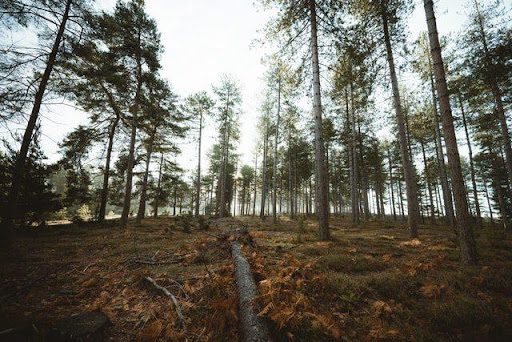Trees can get old, over mature, and become malformed and unhealthy. Landowners must manage their land actively to make room for new trees while responsibly culling diseased or undesirable trees. That’s where timber harvesting and logging come into the picture.
Despite scientific consensus that logging is a beneficial process for most woodlands, there’s still a stigma surrounding logging born out of poor harvesting methods in the 18th and early 20th centuries. At Tall Pines Forest Management, we understand landowners’ environmental concerns around timberland practices.
Considering these concerns, we have outlined the benefits of logging and why harvesting trees is sustainable and responsible.
 First, What is Logging?
First, What is Logging?
Logging refers to harvesting trees from a property for sale and processing into products, often at a sawmill. Loggers fell, cut, and prepare trees, pulp, or timber that is later used in construction, furniture, and paper. The industry formally began in 1607, and the lumber industry has become an important pillar of the US and many other nations with rich forests since then.
Logging has been stigmatized as a land clearing practice with little to no regard for wildlife habitat and ecosystem. That’s far from the truth. The science-based logging practices today focus on biodiversity and environmental protection. Logging makes wildlife more viable because it mimics the natural disturbances to promote forest growth and early succession of wildlife habitat.
The Many Benefits of Logging
Logging is an on-site process where large machinery and skidders are used to skid, cut, and load timber, logs, or trees onto trucks. Read some of the benefits of logging below.
Diminished Risk of Fire
Since loggers cut trees, it helps to prevent the rapid spread of any natural fire. Logging helps protect a forest from an unexpected forest fire and saves various wildlife living in the forest. This is already a very minimal risk in Maine and New Hampshire, but considering the mass devastation in the Western parts of the country, reducing this risk is certainly desirable.
Promote Forest Regeneration
Sustainable logging and timber harvesting promote forest regeneration. This is the process where new trees are grown by making room in the understory and canopy. The free space in the canopy and understory increases access to nutrients, sunlight, and water to encourage new plants and trees to seed and grow. This speeds carbon capture by introducing more new trees.
Improve Timber Value and Quality
One of the benefits of logging is that it improves the quality of timber. Trees are marked selectively to ensure ethical and sustainable harvest. Timber can be harvested every 10-15 years, which can be a great source of profits for landowners. Continuous maintenance benefits the productivity and overall health of timber stands. It also alters species composition, reduces the stocking level of the stand, and removes over-mature, poor-formed, and unhealthy trees to ultimately raise the value of timber.
Increase Biodiversity
We’ve established above that harvesting trees can manipulate the stand composition to improve biodiversity. Doing so makes room for a wide array of wildlife species that can make their habitat in the native trees of different age classes.
For instance, when more air and sunlight reach the forest floor, it encourages the growth of ferns, grasses, bushes, and other plants that are desirable for biodiversity and wildlife habitat. These plants have a shorter lifecycle than large trees. They also grow, mature, die, and decompose to the ground to add more nutrients for the next fertility. Therefore, logging benefits by allowing more ground for biodiversity.
Enhance Wildlife
Coarse wood debris (CWD) is fallen, or dead tree remains, which can be an excellent source of food, shelter, and cover for wildlife. Many insects live in decaying or downed CWD that wildlife species can use for food. Some amphibians, mammals, and reptiles also live under or in CWD for shelter purposes.
Provide Material
Logging is also a great source of timber and can be used for consumer needs. For instance, it’s used in construction, furniture, flooring, wood, sports goods, fuel for homes and industries, and other consumer commodities. Timber also helps manufacture dentures, fighter planes, skyscrapers, and cars. Many industries use them as raw materials but can also be used daily without us realizing it.
Promote Efficiency and Productivity
Dense and overstocked timber stands are less efficient and grow less productively because of increased competition for vital nutrients, water space, and sunlight. Thinning stands using sustainable timber harvesting methods will allow better access to these vital nutrients for the trees left. This way, forests grow efficiently, faster, and productively.
Assure Safety
Old, diseased, and weak trees are vulnerable. Any environmental factors such as rain and wind can affect them, as can pests that can then endanger healthy trees. These conditions can lead to their fall in undesirable places such as driveways, roads, and sidewalks, causing injuries, property damage, and inconvenience for residents. That’s one more reason why trees are harvested using logging techniques. Foresters recommend inspecting trees during growth partly because, if left unchecked, they can cause serious problems.
Enjoy The Benefits of Logging With Help From Us!
At Tall Pines Forest Management, we understand the environmental concerns and weigh the outcomes of timberland management practices. If you’re looking for logging services in New Hampshire and Maine, you should work with a reputable forester to ensure a beneficial and legal harvest. Reach out to us today to start the planning process and enjoy the many benefits of logging.


 First, What is Logging?
First, What is Logging?
picer3cr3
good
logging is good
logging good
LOGGING IS BAD
Logging so cool
thanks for the information got me a 100
this information is very helpful thank you. but did you know the problems with logging?
Thank you for the information I hope i get a good grade on my speech.
log
Logging is bad because Bad for the environment like deforestation that decreases the oxygen released into the air.
Climate change that heats up the earth and can cause global warming.
Floods because the trees roots aren’t holding the dirt causing floods and landslides.
Soil erosion that can make the place that can’t plant anymore.
Can make the animals extinct because when cutting trees you are destroying the animals habitats causing migrating or go extinct.